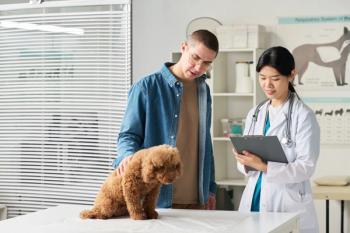
6 savvy tips for the surgical suite
From autoclavable shoes to less-mess cautery, veterinary surgeon Dr. Jennifer Wardlaw shares a few of her favorite surgical solutions.
Dr. Wardlaw says that this headlamp, though designed for outdoor explorers, is perfect for surgical explorers too. Learn more below. (All images courtesy of Dr. Jennifer Wardlaw.)With 15 years of veterinary surgery under her belt,
Shoes that shine
“In this profession, shoes matter,” says Dr. Wardlaw. She wears
Light the way
Whenever Dr. Wardlaw posts pictures of herself on social media wearing this headlamp, everyone wants to know what it is. Answer: the Icon Headlamp from Black Diamond. This lightweight, mobile and super-bright headlamp (500 lumens for under $100) was made for climbers and spelunkers and the like, but Dr. Wardlaw thinks it's perfect for surgical explorers too. “It gives off a really nice uniform light (so you don't have a halo), and the strap that sits on top of my head helps keep the lamp in place,” she says. “If you're not going to be anchored or tethered to a fiber optic light source, this AA-battery option is amazing.”
Patient prep with veterinary "Windex." Veterinary Windex?
Dr. Wardlaw has a DIY trick up her surgical sleeve-and it looks like a bottle of Windex. The self-made spray is like a liquid version of Avaguard or Sterillium hand sanitizers that she uses for final surgical patient prep in most surgeries. “Instead of a sterile scrub with povidone-iodine, chlorhexidine, etc., I use a spray that I make by combining ethyl alcohol 99% with chlorhexidine (2% or 4%), using a 3-to-1 ratio,” she says. “The idea is to keep the alcohol concentration well above 66%, while the chlorhexidine provides long-lasting residual antibiotic activity.” The concentrations are very similar to what's in commercially available Avaguard, Dr. Wardlaw says.
To use, Dr. Wardlaw does her rough prep, and then once the patient's ready, she sprays the area she intends to operate on and lets it dry.
Dr. Wardlaw admits that the spray does have a few issues worth noting-all of which are normal concerns when using alcohol. “You don't want to get it on your cautery plate because you'll ignite your patient, you don't want to use it on a mucous membrane due to irritation, and you don't want to use it on tiny patients because the alcohol can make them cold,” she says.
Bring the heat
“One heating option during surgery isn't adequate,” says Dr. Wardlaw. “After the pet has been in surgery for 20 or 30 minutes, you're less likely to bring their temperature back up as it comes down with just one thing. You need to start adding two or three heating elements proactively with small, young and thin patients and for longer surgeries.”
Dr. Wardlaw uses a wide range of cheaper and DIY options to keep patients cozy: hot water bottles, DIY hot water bottles (i.e. hot water in IV bags) and tube socks filled with lentils that can be warmed in the microwave. She also likes to use a fluid line warmer or wrap the fluid line around a hot water bottle. Whichever method you choose, heating the fluids close to the patient is key. “If you apply heat all the way at the end of the surgery table, the fluid cools down by the time it reaches the patient,” she says. “The closer the fluid warming element is to the patient, the warmer the fluid will be when it reaches it.”
To ensure that her patients are breathing warm air, Dr. Wardlaw often puts a warming element on the anesthesia circuit tube before it enters the pet's airway.
“A lot of people are also loving the thermal blankets that come in emergency kits too,” says Dr. Wardlaw, “but it's important to put it on the patient while it's still warm. It can't rewarm a patient. It needs body heat to start with.”
Dr. Wardlaw says she likes
Wet paper towels enhance conduction without making a mess.Less-mess cautery
Cautery can get a little messy when the patient's fur meets ultrasonic gel. Because Dr. Wardlaw uses cautery on almost every patient, she's found a way to make the process less annoying. “Traditionally, we put ultrasonic gel on the ground plate to enhance conduction. To get the same benefits without the mess, I soak paper towels, washcloths or towels in water and place them between the pet and the ground plate,” she explains. “If the pet has a really thick coat, I'll pour water between the patient and the ground plate to give it that contact. As long as you're not in surgery for eight hours and your plate dries out, this method gives you plenty of contact without any hot spots or sticky, matted fur.”
However, Dr. Wardlaw notes that if ultrasonic gel is your thing, it's easiest to remove if you comb it out with alcohol later, as the alcohol will dissolve the gel.
Creating a sterile, water-impermeable foot wrap with small pieces of drape.
Wrap right
Dr. Wardlaw's DIY solutions extend to contamination control as well. “There was a really nice
This, Dr. Wardlaw explains, is a problem: “You can take 20 layers of Vetrap, place it over the top of a cup of water and tip it upside down, and that water will eventually seep through the wrap. So when the patient is bleeding or you're using lavage, and you're touching the foot to manipulate the leg, you've got free-flowing bacteria in and out of that foot wrap,” she says.
To remedy this, Dr. Wardlaw cuts a little spool of water-impermeable drape that she calls “foot wrap” and puts it in all of her orthopedic packs. It looks like a short spool of wrapping paper that she wraps around the foot after capturing it with vet wrap. “I know some veterinary professionals who autoclave aluminum foil and wrap it around the foot,” she adds. “You just need to make sure that whatever you choose to use covers all of the Vetrap.”
Stay tuned ...
One more item on Dr. Wardlaw's bag of surgical tips and tricks: a surgical checklist. “If you don't have one, you need one,” she says. Check back to dvm360.com next month for a free downloadable surgical checklist.
Newsletter
From exam room tips to practice management insights, get trusted veterinary news delivered straight to your inbox—subscribe to dvm360.




